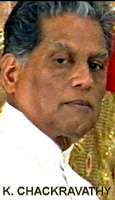
SATHYA SAI BABA AND THE WATER PROJECTS
Note: The water projects in Rayalaseema, Andhra Pradesh, Medak and Mahabubnagar, and the canal repair for Chennai financed by followers of Sathya Sai Baba and named after him are no doubt admirable for those who suffer water shortages and now receive more than before. Much was achieved, while much went wrong, and no one connected with Sathya Sai Baba is allowed to mention anything negative about these projects, which are widely promoted as 'Divine Miracles'. This article is therefore simply to help correct some of this totally one-sided propaganda. I repeat, this is not to denigrate the good intentions of those who donated (including myself!) nor whatever positive results have been achieved. (See here) Rather, it is simply to counterbalance the mendacious aspects of Sathya Sai baba projects and what most of the Indian media have become afraid to publish concerning anything critical of what government-protected Sathya Sai Baba says or does and so contributes to many public misconceptions. See for example http://www.thehindu.com/todays-paper/tp-national/tp-andhrapradesh/villagers-protest-water-scarcity/article3891446.ece
Major deficiencies and wastage:
Sathya Sai Baba initiated the Rayalaseema Water Project, and though it was a huge and well-intentioned affair, it was nevertheless also seriously flawed and soon broke down all over the place. The water table fell during the planning (despite the repeated claims of Sai Baba that he is omniscient, omnipotent and that nothing to which he puts his will can ever fail!) As reported here: "However, the declined water table has rendered the infrastructure built for the scheme worthless. The work on Chitravati balancing reservoir going on at a snail's
pace resulted in this situation. The irregularities and subsequent enquiries on the works have affected the Satya Sai Scheme." Nonetheless, Sathya Sai Baba had to ask the Andhra Pradesh state authorities (his devotees among them) to take over the entire running and further financing of the project at the taxpayer's expense. Sai followers around the world supported his call for a Water Project in Rayalaseema – donating quite huge sums (Rs. 3000 crores by 1998) and the original project involved river dams, reservoirs, wells, boreholes and over 2,500 kms of pipeline. Though he claims to have no money or property, he speaks of this project virtually as being at his own expense “If there is constraint of finance, I am prepared to meet the cost even if it is 100 or 200 crores for fulfilling this dire need of the Rayalaseema people.” (Sanathana Sarathi, 12/94, p. 323.) It is a fact that several major drinking water projects are now funded by The Sathya Sai Trust, like "Sathya Sai Ganga Canal" 200 crore water project which brought water from the River Krishna in Andhra Pradesh to Chennai, on the Godavari River for the five hundred villages in East and West Godavari Districts, the Medak District Project, the Mahbubnagar District Project. These are valuable solutions to some of the water problems in Andhra and Tamil Nadu, but are actually dwarfed by other State-run and financed water projects.
My old friend V.K. Narasimhan told me in considerable detail how the Rayalaseema Water Project was botched, not least because Sathya Sai Baba forced it to open on his 70th birthday celebrations, just so that he could preside over its inauguration twice over with maximum fanfare by the Indian P.M. Narasimha Rao and again next day by the President of India, Dayal Sharma. The central pumping station broke down during the inaugural ceremony. The President of India pressed the lever, but the system failed! The fact was covered up immediately, of course.... very auspicious for an infallible avatar's miraculous project! Various sub-contractors delivered sub-standard materials and did poor work, while no one in any of the villages could be found to help maintain it. That is partly why it fell into the lap of the State political bureaucracy. Compare that project and his repeated proud trumpeting to this day of 'his project' with Bob Geldof's 'Food for Ethiopia' project, taking no credit himself other than 'it was my good luck to be there at the right time and place'! The Sai water project did not function 'at the right time and place', despite the claim was that it was yet another exhibition of this Avatar's almighty miraculous power that it came up and in time for his birthday. (His many building projects have been very widely promoted as being possible only by his personal miraculous intervention as miracles, such as the Poornachandra Hall, the Sarvadharma Sthupa, the Dharmaksethra building in Mumbai, the so-called 'Super-specialty' Hospital in Puttaparthi and many other of his projects.
There are often considerable losses of money through wrong investment by Sathya Sai Central Trust (long presided over autocratically by him), plus embezzlement and huge funds misspent on wasteful buildings (many have been pulled down and the site reused). No one can tell where the money not used is spend or placed, as the Trust publishes no details and any minutes (if kept at all) are highly secret. A complete absence of accountability operates throughout Sathya Sai officialdom in India (also to varying degrees in his organization in most other countries). Those relatively very few people who are properly aware about the extent and depth of corruption in India, the pay-offs, kick-backs and ingrained financial peculation throughout most of the country will not be surprised. Especially foreigners are kept in the dark as much as possible by a kind of public conspiracy (No one has explained this in greater detail than the famous Bengali, Nirad Chaudhuri). I write this simply to warn and try to redress some of the cover-ups about money matters in the Sai mini-empire, money which was pledged to raising the lot of the poor through education and help projects. I learned from IAS officer V. Ramnath and V.K. Narasimhan that the man who was chosen as the overall leader of the Water project and its finances, Mr. K. Chackravathy (or Charkravathi) had been forced to resign from his post as an Indian Administrative Service official (a government post) in 1981 (i.e. 'sacked') and leave the post he had held for 20 years because he was caught out in major embezzlement of public funds (i.e. peculation)! He became the registrar of the Institute of Higher Learning and is now secretary of the Sathya Sai Central Trust, the fulcrum of Puttaparthi and is also head of the Prashanthi Nilayam ashram. He is no doubt rolling in millions. Asked about this kind of corruption once by the former head of the Indian canteen - a very long-serving strict Hindu - Sathya Sai Baba said to him 'God allows his cows to defecate where they will'.

When Satya Sai Baba celebrated his 70th birthday in November, 1995, the President and the Prime Minister of India were in attendance and applauded the Satya Sai Water Scheme meant to provide drinking water to every village of the dry district of Ananthapur. It is a matter of great concern that five months after the inauguration, water is yet to flow from village taps, as tanks have crashed and pipes burst because of inferior construction material used due to corruption. Importantly, this is an instance of how and when governments default in their duties, religious organizations occupy that space. (by Babu R.R. Gogineni - Former General Secretary of Rationalist Association of India) see http://www.uni-giessen.de/~gk1415/sai-baba.htm
Even in 2013, nearly 20 years later, the water shortage situation in the Rayalaseema area (as well as in much of Andhra Pradesh, Karnataka etc.) is yet worse. See up-dated coverage of this here: Sai Baba and extreme water scarcity in Anantapur for years
Incompetence and corruption of entrepreneurs beyond Sai Baba's omnipotent control?
"Divine resolve is always true resolve. Remember there is nothing that divine power cannot accomplish. It can transmute earth into sky and sky into earth. To doubt this is to prove that you are too weak to grasp great things, the grandeur of the universe.” (43rd birthday Discourse, 23 November 1968)The water project did begin in 1996, very unevenly and only in a fraction of the villages where it was supposed to be installed, leading to many disturbances by divers villagers in the Rayalaseema area variously reported in the local press. All that is carefully suppressed by the Sathya Sai authorities in their lavish hand-outs and web pages praising the project to heaven. Nonetheless, this has done a lot of good to some villagers. However, already in 1996, the Sathya Sai Rayalaseema Water Project was shown to be a considerable failure due to unforeseen natural circumstances, as the report from Andhra Pradesh Regional News Network showed (see whole article below). Further, he had not predicted - nor miraculously altered - what proved to be a drastically sinking water table nor on flawed engineering plans or corrupt entrepreneurs!
Despite claims of his omnipotent miraculous power, Sai Baba could not even predict the huge fall of the water table in Rayalaseema and the Anantapur District generally, let alone stop it. Further, he is reported by numerous devotees to have stopped rain from disturbing his activities and turned back floods when the Chitravati River overflowed and threatened his ashram. The propaganda about the water project as being Sathya Sai Baba’s ‘miracle’ goes on, even though he had to palm off the entire unmanageable and failing white elephant to the Andhra Pradesh government to sort out and try somehow to run. Unfortunately for the suffering population of the Anantapur region, the water table has continued to fall causing greater and greater shortages of water, as is the case throughout large areas of Andhra Pradesh.
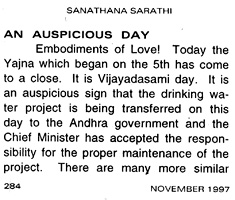
ANANTAPUR DRYING UP (from http://listserv.nodak.edu/scripts/wa.exe?A2=ind9806&L=telugu&P=R2)
Anantapur: Even the Bhagwan Satya Sai Baba found it difficult to supply uninterrupted drinking water to the drought ravaged Anantapur district. According to official
sources the ambitious Satya Sai water scheme is hampered due to a sharp decline in water table in Chitravati river bed on which the scheme hinges.
Larsen and Toubro has finished its part of the work of installing pipelines and infiltration wells. The scheme is bifurcated into two projects one of which covers 76
villages from Perumpally to Puttaparthy, while the other project envisages to quench the thirst of the people of 91 villages in Chinnakotla, Mudigubba, Madiri region.
However, the declined water table has rendered the infrastructure built for the scheme worthless. The work on Chitravati balancing reservoir going on at a snail's
pace resulted in this situation. The irregularities and subsequent enquiries on the works have affected the Satya Sai Scheme.
We hope that the present state of affairs does not persist for long. "Once the reservoir is complete we will be able to regularly supply water to the targeted
villages," said an engineer KV Sanjeeva Reddy, who works for Satya Sai Water Board.
According to a contract the Larsen and Toubro is to handover the maintenance responsibilities to the Board after the stipulated one year period.
Right now, the officials at the Board are holidaying at the cost of public money as there was little work to do. Under the Satya Sai Scheme six infiltration wells
were dug at various points in Chitravati river bed.
Each well was expected to supply 30 million liters of water every day. Due to the sharp decline in the water table not even half of the capacity of the costly
motors and pump sets was being utilized. Recent stray showers did not help increase the water table.
"We had high hopes on the scheme. water was supplied to us only for 20 days since the past eight months," a municipal engineer at Kadiri lamented. "The scheme's
future depends on the competition of Chitravati reservoir and it is an unlikely prospect at least for 2 or 3 years to come.
Severe scarcity in Kadiri: Shortage of water is a perennial malady in several towns of Anantapur district. Civic bodies are unable to meet the increasing demand due
to scant resources.
According to governments own stipulation a town consisting of a population of 75,000 should be supplied with 15 lakh gallons every day. Leave
alone the standards, people in several towns are not even getting sufficient water to fulfill their barest minimum of needs.
For example Kadiri town has a population of 91,000 according to latest census. "We supply 6 lakh gallons of water every day. half of this supply
is untreated. High content of fluorine in raw
water were called for its treatment to reduce the chemical content," Kadiri Municipal commissioner Ajay Kishore told Deccan Chronicle.
"So in Madras, rich people gave some money and are they are drinking good water. But the poor people and beggars, not having money in hand, are drinking polluted and dirty water, and are succumbing to diseases. I have the desire and have resolved to give pure water to them, to sacredly protect and develop their health, generation after generation, so they can be happy. "Only yesterday, the three, Secretary, Mr. Chakravarthy, Mr. Srinivas from Madras and Mr. Indulal Shah from Bombay, went together to the authorities of the World Bank. They went and explained our sacred seva. They said that this is not merely our (selfish) service. It is seva (selfless service) that we do. We won't experience any results (benefit personally). We won't aspire for results. It is seva that is done without desiring for the results. I told these three this, and they went to the World Bank authorities and repeated these words parrot-like. "All the authorities of the World Bank came here. They declared, "We have not heard about and we have not seen, in any place or in any country, this kind of seva. (Applause) Sathya Sai Baba is giving water like this to Madras which is somewhere else (far from Puttaparthi)." Today a phone call came saying that the World Bank authorities had said, "We will give the entire cost of this." (the project to supply drinking water to Madras) (Applause) "See! On Ugadi day! Sacred results will come when there are sacred feelings. "The Bank authorities said, "You don't need to think anymore (worry) at all. You don't need to come to us again. We will give help to you. We will give any number of crores." (One crore is ten million rupees.) "How great it is that such an enthusiastic feeling came! Twelve hours have not yet passed. They came last night at 7PM. The phone call came at 7AM in the morning when I was coming out. Do you see?" |
Despite these claims, there is absolutely no evidence in any of the World Bank's extensive web sites (as of June 2008) that any project of Sathya Sai Baba has received any loans from the World Bank. Loans are made to national states and a World Bank administration within that state distributes the loans to projects it support. These are of course listed in public. Neither the 'Sathya Sai Ganga Canal' project to repair water supply to Chennai - nor any other Sai Baba projects are registered with the World Bank.
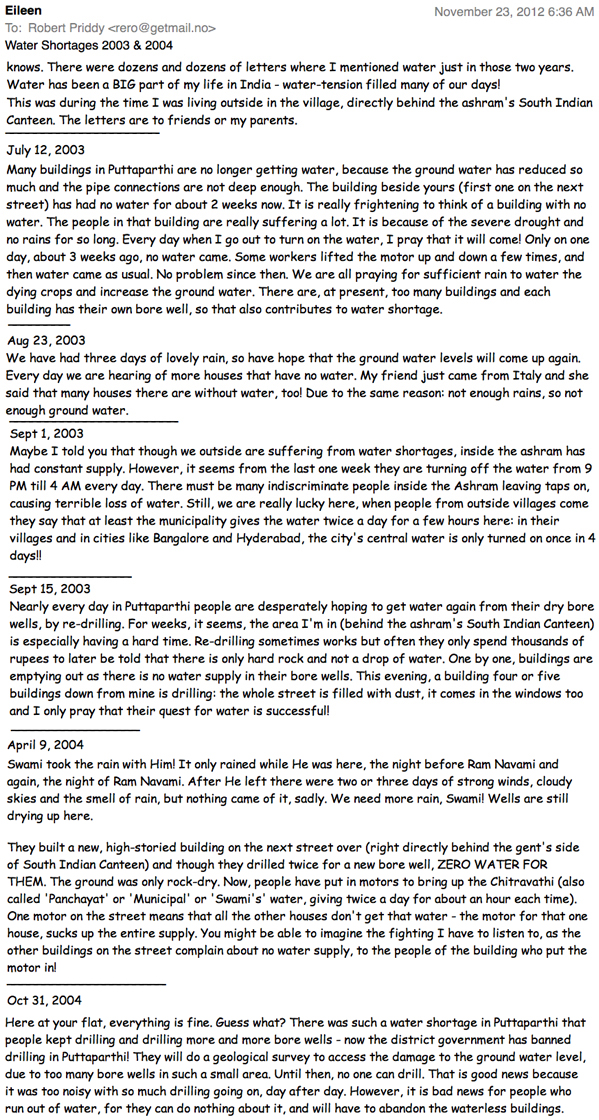
In 2014, the following was reported from Puttaparthi by e.mail:-
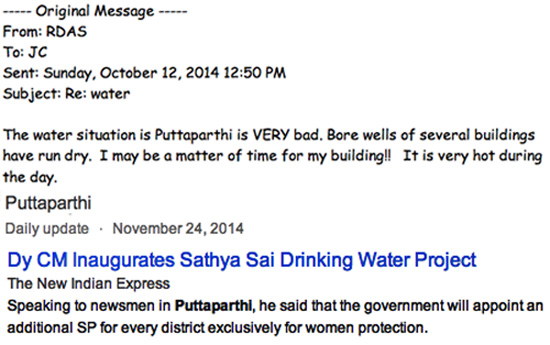
Telegu Ganga -
Sri Sathya Sai Drinking Water Project for Chennai
http://www.saibaba.ws/service/teleguganga.htm
Source: Radio Sai E-Magazine, February 1, 2004
http://www.radiosai.org/Journals/Vol_02/03Feb01/02_Cover_Story/04b_telugu_ganga/telugu_ganga.htm
The inauguration of the Telugu Ganga project, 1983. The project failed to deliver, with very little of the promised water reaching Chennai.
Basava Premanand (Indian Skeptic - deceased 2009) had very widely exposed the controlling influence of Sathya Sai Baba and his minions in many State affairs - also putting Sai Baba beyond the law of the land:-
SAI BABA'S PIPE DID NOT DELIVER WATER
"Let us discuss about the Sri Sathya Sai Drinking Water Project which was inaugurated by Ex-Prime Minister P.V. Narasimha Rao and Indian President S.D. Sharma, Newspapers vied with each other to tom-tom the benevolence and greatness of Satya Sai Baba."
See video clip here)
"TIMES OF INDIA Dated 3.12.95 came with the following news under the heading “Basu Waves Tax for Sai Trust.” The left government has granted sales tax exemption to the tune of Rs.60 lakhs to an organisation run by Satya Sai Baba. The government decision was communicated to the Sales Tax Commissioner on November 11 by a joint secretary in the department of finance for issuing the official notification.” ' Informed sources revealed that Sri Sathya Sai Central Trust’s unsigned petition for exemption of central sales tax leviable on purchases made in West Bengal for a drinking water supply project in Andhra Pradesh was placed before Chief Minister Jyoti Basu in October by Padma Khastigir, leader of the Congress opposition in Calcutta Municipal Corporation and a Former Judge of Calcutta High Court. The official added that the Trust has been granted sales tax exemption by 3 other state governments. The Trust’s petition to Mn Basu stated that it was unable to bear the financial burden of paying sales tax and pleaded for exemption on humanitarian grounds. An official in the CM’s secretariat said that the concession “although unprecedented in the states has been made in the peopIe's interest..."
"With all the fan fare in news papers, television and radio all over the world the people believed the magnanimity of Satya Sai Baba. As the Prime Minister and the President had inaugurated and the water gushed out from a silver tap to a silver vessel and the audience saw the water gushing out they all believed that the parched throats of the people of Anantapur District have been quenched by giving them pure water. -No one enquired as to what really happened. Immediately the water flowed through the pipes, the pipes burst at the starting points of the water supply, and the parched earth with the dried blood of the six watchmen of Sai Baba, got satisfied after quenching its thirst. When the president knew of the real fact after his inauguration, he fell sick, President Shankar Dayal Sharma was slightly indisposed on Wednesday night, according to member of the presidential entourage reported UNI. Dr. Sharma, who was here for the 70°‘ birthday celebrations of Sri Satya Sai Baba, has suffered from a bout of pain following ‘inflammation of his knee' and could not attend a scheduled function here"
"Though billions of cm water was wasted and big pools were formed near the pipe lines no news paper, or the TV or the Radio had the courage to publish about the fraud. In April only one newspaper in Telugu “Vaartha” published a series of articles for 9 days on the Sri Sathya Sai Drinking Water Supply Project where Sai Baba's pipe did not deliver water to the parched people of Anantapur. lmmediately after getting the information l rushed to Anantapur and on 21" April and 23” April made a video him. According to Times of lndia dt.3.12.1995 the judge Padma Khastagir as a self-confessed Sai`Baba acolyte for 25 years, frequently visiting the godman’s ashram. Her four-storey house in Southend Park is named Sai Sudha after the controversial godman. Such a judge to lile an unsigned petition for sales tax exemption and the Chief Minister to exempt the trust from paying sales tax is gross negligence and proves that Sai Baba is above Indian Laws. This act of the judge is a shame to the chair she had occupied as a judge so also the Chief Minister of West Bengal ordering exemption on the basis that Sathya Sai Trust was unable to bear the financial burden of paying sales tax and pleaded exemption on “humanitarian grounds" while it was the richest trust in the world. As law is said to be same for every one, I am wondering if the state and central government would exempt the people who are below the poverty line from all taxes?" [1995]
[some excerpts from Part 4 of the book 'Failed Sabotage by SSB through Gerald Moreno' publ. by Basava Premanand - p. 230]
PARAMAPALLI TO PUTTAPARTHI
COMPREHENSIVE DIVISION OF PROTECTED
WATER SUPPLY SCHEME
21.4.1996
From Anantapur we travelled a distance of about 28 km to reach
Malyavantham via Bethalpalli where at 1/4 km of approach road on the either
side, work of rectification of the pipe line was going on. The tirst videograph is
of the right side where the broken pipes were taken out because the pipes
burst out when water was released for lack of strength of pipes, want of sand
cushioning, p roper bends and want of air valves. The pipes could not withstand
the pressure when the water was released. This particular comprehensive
part of the scheme is the chief point of the whole scheme covering the district,
for it should take water from this particluar point only to the abode of Satya Sai
Baba at Prasanthinilayam situated nearly 130 km away from the ground level
service reservoir (GLSK) from where through gravitational force the water will
be carried to the terminal point of consumption. lt starts from the river bed of
Chitravathi and the supply source being under ground water. ln the video it is
clearly seen that there was no sand cushioning as technically required and as
well as leveling is ignored in laying the pipe line which is the basic of the pipe
line technology. For want 'of air valves at the required spots and for want of
required material strength to withstand pressure, resulted in bursting of the
pipes. lt is learnt that standard specification of ACC pipes should be between
16 to 18 kg per sq.cm where as the inlaid pipe line strength is 2 kg per sq.cm.
The most shocking aspect here is, rectification is not rectification because it is
going: to fail again for want of the strength of the pipes as the same pipes are
laid again after cutting the damaged portions. This will lead to a vicious circle
of again rectfication and leading to fail again till pipes of the specified pressure
strength are used. Thus, in this way if pipes break, water will never reach
Prasanthinilayam or the villages in between.
Another point of our assessment is in the providing of air valves on
most unscientific way. ln the first instance no air valves were installed even for
5 km distance at least. So, in the repair stage they are in excess, which would
result in the passage of air only instead of water. The present rate at which
they are installed is one for every 50 meters as seen in the video which clearly
indicates lack of knowledge of pipe line technology of Larsen & Turbo. As
water should not flow through the air valves as seen in the factual scene on the
videograph.
Near Pullampalli the designed defect is itself clear and money is simply
thrown into the gutter. Because at the first instance, they thought of going for
a sump from where water had to be pumped to GLSR, but later they altered it
after finishing the sump foundation to go for direct pumping to GLSR without
sump. A gross deviation at whim, and fancy. The partly finished sump can be
seen in the video film.
The common principle of proper future maintenance is ignored and
have gone to the extent of encroachment, infringing the fundamental rights of
citizens to property which naturally would lead in a civil suit staying the supply
of water to pass through a private land after completion of work.
The
videographic evidence of the owner is that they have threatened him that he
will be put behind the bars and also make him liable to pay compensation of
Rs.1000 per hour to the contractor which is against natural justice and our
constitution. Because the pipe line which may arise in future either voluntarily
or after taking due compensation from the concerned, duly authenticated and
recorded for smooth functioning of the scheme. Here instead of taking the
pipe line along the road they have taken a curve through the private property
probably because it is the shortest route, which if required must have been
used after proper authority of title over the land.
The so called economy measures adopted to in the design remind us
of the saying “Penny wise and pound foolish". Because pre-cast iron bends if
used will give maximum strength to the material to get rid of the burden of
breakage compared to the normal straight pipe which cannot be had by cutting
the pipe and joining it at the required angle as the joining material cannot have
the sustaining capacity against the pressure of the flowing water. So the water
pipe will break near the joints immediately when the water is released through
the pipe line, which would again require rectification and which cannot be
rectified if the same principle of joining after cutting is adopted to.
The most gross violation of law is in the employment of child labour in
such a risky project that too under the hot sun on the mid summer. It is even
ethically unjustified in terms of humanness which the godman always preaches
and forgets to practice.
THE VIDEO COVERAGE OF SATYA SAI WATER SCHEME AND THE INTERVIEWS WITH LOCAL VILLAGERS ON 21.4.1996 we visited the villages, Pullampalli, Puleobalayyapalli. The leakage spots have been videoed. At Pallampalli a farmer was interviewed about the pipe line going through his lands. Question: Did you give permission for taking the pipe line through your lands? Answer : No sir, I had objected at the time of the work, but the contractor threatened me by saying that for the delay you have caused, you will have to pay one thousand rupees per hour. Then I was afraid to object. They have laid the pipe line. Question : Is the water coming to your village? Answer : No, not coming. Question : Why? Answer : Due to leakage of water, it is not reaching up to the distribution point. Some of the leakage points are covered in the video. Broken pipes are also covered. 23.4.1996 We visited Suganmala, Kondapuram, Rayalcheruvu, Naganur in Tadapatri area. The following is the interview recorded on the videograph: Question : What is this pipe line? Answer : Sai Baba's water. Question : Is the water coming to your village? Answer : No, not coming. Question : Did they release water? Answer : Just for one day they have released. But due to pipe bursting they have stopped the supply of water. They have repaired, but leakage has not stopped. Question : Why is it so? Answer : The pipes are not laid properly. There is no level. Due to lot of ups and downs, the water flow is not proper. The pipes used are not withstanding the pressure. The pipes are also full of cracks. Every where there is leakage of water.
The pipes used are not properly cured, inferior quality and so could not withstand the pressure. The work is not executed properly. The work was done hastily and planning is not proper. These are the main factors in failure of this scheme. Though lots of money is spent, the scheme has failed. Contractors are also not fully paid. L&T are the main contractors. The supervising staff is not experienced. They have recruited many youngsters who have no experience at all in execution. All this lead to the failure of the scheme. L&T have given the contract to sub contractors at double the rate of the government and got the bills. 20 to 30% is not paid to the contractors though they have received the receipts from the sub contractors. The Central and State governments have exempted the purchase of materials from Central Excise Duty which is 25% and sales tax which is 10% or more. The suppliers have billed for more quantity than it is necessary and thus duped the government. The State Government also has paid Rs. Thirty crores for the scheme to the Satya Sai Trust. T ` With the exemptions and the Rs.30 crores given as gift the Government could have very well given water to the people of Anantapur District.
from 'Failed Sabotage by SSB through Gerald Moreno' published by Basava Premanand 2007 [copyright Indian CSICOP] (696 pages) p. 231f
OTHER SOURCES ON THE RAYALASEEMA WATER PROJECT
Ramana Baba, also known as Muz Murray, reported to me:- "Investigators however, maintain that these claims have another side to them. It was found that the authorities had previously refused permission for a water pipe solely for the private use of the ashram, unless other villages on the way were also supplied, as many in the region were without water. Permission to lay 2000 km of pipeline to the ashram was only granted after accepting this proviso. But even though some of the villages of the Rayalaseema region through which the pipeline runs are now getting good water, others say that half the pipelines are blocked or badly fitted and they are still not getting a supply."
SATHYA SAI BABA AND THE WATER PROJECTS - FULLER FACTS COVERED-UP
The water projects in Rayalaseema, Andhra Pradesh, Medak and Mahabubnagar, and the canal repair for Chennai financed from donations made by followers of Sathya Sai Baba (and subsidised by government) were named after Sathya Sai Baba. They are no doubt admirable for those who suffer water shortages and now receive more than before. Much was achieved, while much went wrong, and no one connected with Sathya Sai Baba is allowed to mention anything negative about these projects, which are widely promoted as 'Divine Miracles'. This article is therefore simply to help correct some of this totally one-sided propaganda. I repeat, this is not to denigrate the good intentions of those who donated (including myself!) nor whatever positive results have been achieved. Rather, it is simply to counterbalance the mendacious aspects of Sathya Sai Baba projects and what most of the Indian media have become afraid to publish concerning anything critical of what government-protected Sathya Sai Baba says or does and so contributes to many public misconceptions.
http://dlc.dlib.indiana.edu/dlc/bitstream/handle/10535/1094/nikku_water_040513_paper088.pdf?sequence=1
3.4 The Non Governmental Initiative
On January 19,2002 Sri Satya Sai Baba, the founder of the Sri Satya Central Trust11 and
enjoys huge followers announced that he would do something to provide drinking water
to Chennai. Soon after his statement, a 200 crore project has been designed and work was
began in October 2002. The estimation of the labour creation is about 4000 workers and
50 site engineers toiling round the clock.
The trust focused the lining work of the main canal in between Kandaleru and Poondi
Reservoirs. In addition to lining of the canal, additional gates and storage tanks were
proposed to increase the capacity o the Kandaleru reservoir from 16 tmcft to 68 tmcft.
The lining will enhance the canal flows and arrest the seepage losses along the canal.
The trust with the technical help of L&T a reputed construction company took up the
initiative. They have invested more than 200 crores (exact amount is not available, as
lower department officials are not aware) and completed the lining in many parts between
Kandaleru and Poondi reservoir (K-P canal). The Sri Satya Sai Trust has plans to
complete 60 kms length of canal in the first phase with the technical help of a leading
private infrastructure company. canal, recognising the contribution of Sai Trust. According to the Assistant Engineer at
Satyaveedu irrigation sub division the water is reaching the ‘0’ point much faster than
earlier. In the past it used to take two days to reach water to zero point which is now
reduced to half a day.
“The completion of 80 percent of the water project sponsored by Sri Satya Sai Central
Trust, have raised many hopes of Chennai-ites” states the popular news daily The Hindu
(dated 25, June 2003). However farmers from upstream complained that earlier they were
receiving seepage or leakage water from the canal which they have sued to irrigated their
irrigated dry crops. With the canal lining this has stopped and government did not
complete the net work of canals proposed to supply water to their plots. The farmers from
Satyaveedu and Varadapalem Mandals are un happy about the delay in the government
work. As a result one can see a row of diesel run water pumps on the last reach of lined
canal. The evidence suggests that the farmers find alternatives to irrigate their plots at any
cost. It is an issue of food security vs drinking water users.
In 2007, FAO Newsroom reported on the problems of coping with water scarcity in Andhra Pradesh, stating "--- indiscriminate drilling for water -- the number of wells in Andhra Pradesh increased from 800 000 in 1975 to 2.2 million in 2002 -- and increasing use of chemical fertilizers and pesticides are a potential threat to groundwater resources and reduce land fertility. Insurmountable debts due to lost investments in failed bore wells have driven thousands of farmers to the brink of desperation, many to suicide. But an innovative project, funded by the Government of the Netherlands and implemented by a network of local non-governmental organizations with technical assistance from FAO, is beginning to turn things around. The key: enabling rural communities understand the groundwater system so they can deliberate among themselves and make appropriate decisions leading to better investments and efficient management of their water resources."
Unfortunately the water table dropped catastrophically in the period 2011 to late 2013 causing untold misery. Boring wells often gave no result even at great depths- Only rainfall could ease the problem, raising the water table enough to make some bore wells usable.
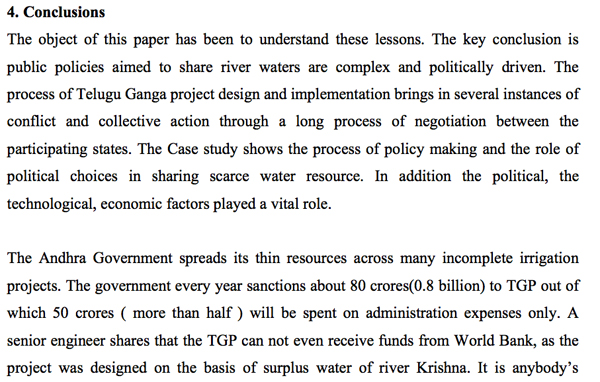
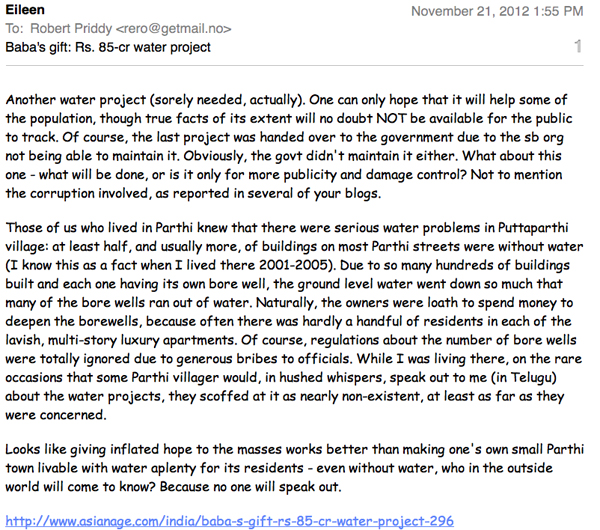
See also
Rayalaseema ryots block roads demanding water
Major water problems still on Sai Baba's doorstep - Urvakondu area, Andhra Pradesh
Handri-Neeva Project Rs 2,100 crore water project, (not Sathya Sai Baba funded)
1) Print this Page 2) Use right click here - then 'Open page in new window' to translate